How Much Does It Cost to Install a Gas Fireplace?
Gas fireplaces are an attractive and energy-efficient way to heat a room. The installation of this type of fireplace is easier than many wood-burning options. They cost less to run, making them an excellent retrofit for homeowners who want a fireplace. Each style is designed for functionality, cost savings on utilities, and operating convenience without a loss to the room’s ambiance.
The national average cost for a gas fireplace, including installation, is $2,500 to $7,000, depending on the model, location, and condition. Most homeowners pay approximately $5,000 to install a built-in gas fireplace unit with a hearth, surround, and mantel on an outside wall. This project’s low cost is $1,000 to install a gas fireplace insert in an existing masonry fireplace. The high cost is $10,000 for a custom stone surround vented peninsula unit and installation of a new gas line.
Gas Fireplace Installation Cost
| Average Cost to Install a Fireplace | |
|---|---|
| National average cost | $5,000 |
| Average range | $2,500-$7,000 |
| Low-end | $1,000 |
| High-end | $10,000 |
In this guide
Custom vs Prefab Gas Fireplace Installation Cost
Gas Fireplace Cost by Type
Cost to Install a Gas Fireplace by Type of Ventilation
Labor Cost to Install a Gas Fireplace
Cost to Build a Fireplace Surround by Material
Gas Fireplace Replacement Cost
Outdoor Gas Fireplace Cost
Smart Gas Fireplace
Cost to Run a Gas Fireplace
Pros and Cons
Maintenance
Gas Fireplace Inspection Cost
Cost to Convert a Fireplace to Gas
Electric vs Gas Fireplace
Wood-Burning vs Gas Fireplace
Gas Fireplace vs Gas Fire Pit Cost
Enhancement and Improvement Costs
Additional Considerations
FAQs
Gas Fireplace Installation Cost by Project Range
What Is a Gas Fireplace?
Gas fireplaces give you the look, warmth, and ambiance of a traditional fireplace, but they burn natural gas instead of wood. The units can be stand-alone fireplaces that are built into your wall, inserts placed into your existing fireplace to convert it to gas, or custom-made setups for the look and style you want. They come in many different types, sizes, and styles and may be used for ambiance or as a primary method of heating a room in your home. They are contained units that require a gas line to operate. This means you must have natural gas running to your home or liquid propane tanks installed to run the unit.
Gas fireplaces produce exhaust and need to vent outdoors. This can be done through a chimney or vent directly through the wall. You can also purchase a ventless gas fireplace in some places, but these are not legal in all states and should not be used in small areas.
Custom vs Prefab Gas Fireplace Installation Cost
Gas fireplaces are technically self-contained units. They can be installed inside an existing fireplace, inside an exterior wall, or built into any wall of your home. The units themselves are prefabricated, and most are designed to be installed as they are without modification. They range from small boxes to large cabinets with their own mantel 1 and built-in surround. They can be very sleek and modern, designed to be installed inside a cabinet or wall or appear like a more traditional fireplace.
Most prefab units can give you the look of a built-in or stand-alone fireplace, depending on the unit. However, sometimes you may want something more custom in how the mantel, surround, hearth, and position of the firebox 2 look. In this case, you want to customize your installation. You are still using a prefab firebox but with a custom installation that gives it a surrounding area to make it look different. This raises the price of the project because it requires additional materials and labor to install.
There can be a wide range of associated costs with both project types. You can purchase a fully loaded prefab unit with mantel and surround to install inside a wall, and you can also build a simple custom fireplace that lets you walk around it on three sides. Both may have similar costs. However, expect to pay more for customizations.

| Type | Average Price (Installed) |
|---|---|
| Prefab | $2,000 - $8,000 |
| Custom | $4,000 - $10,000 |
Prefab Gas Fireplace Cost
To purchase and install a prefab or factory-built unit, expect to pay $2,000 to $8,000 with labor and materials and extending your gas line. Prefab fireplaces come in many sizes and styles. They can be simple boxes that install inside a wall with no surround. They can also be fully finished fireplace units with a mantel, surround, and hearth designed to look like a traditional fireplace. The interior is usually made of metal with refractory panels that may look like bricks on the inside of the firebox. Most need to vent outside through a direct vent or chimney. Having an existing chimney to vent through is the least expensive way of installing. Expect higher costs if you want to create a custom chimney. Most experts can install a prefab unit in a day.
Custom Gas Fireplace Cost
The cost to customize your gas fireplace installation is between $4,000 and $10,000, including the gas line, inspections, labor, and materials. Custom gas fireplaces start with a prefab firebox, and you customize the installation of that box. You can build a custom surround and mantel for a more traditional appearance or help it fit your decor. You can also build out a wall to contain the fireplace in the center of a room as a divider, which allows you to walk around the fireplace on two or three sides. This customization can be very simple or complex, depending on your needs. This is a good way of getting the exact setup you desire if you cannot find a fully finished gas fireplace that meets your needs.
Gas Fireplace Cost by Type
Gas fireplaces can be found in a wide range of styles, sizes, and construction types. They can be simple units on your tabletop or look like some logs you place in your existing fireplace. They can also be sleek, contemporary units you build into your wall or large peninsula 3 units you can walk around as a room divider. Most of these styles are available as a prefab unit, with some also being available to customize on site.
Each fireplace type has its own parameters for size and installation and a cost range. Below are the various fireplace styles and their costs to install with their applicable methods.

| Type | Prefab Price Range (Installed) | Custom Price Range (Installed) |
|---|---|---|
| Gas Log | $350 - $2,500 | N/A |
| Tabletop | $560 - $3,000 | N/A |
| Insert | $600 - $2,000 | N/A |
| Freestanding | $900 - $2,200 | N/A |
| Corner | $2,000 - $4,500 | $2,500 - $10,000 |
| Wall-Mounted | $2,000 - $5,500 | $3,000 - $8,000 |
| Built-In | $2,250 - $5,500 | $5,250 - $10,000 |
| Island | $3,000 - $7,800 | $5,000 - $10,500 |
| Peninsula | N/A | $7,000 - $12,000 |
Gas Log Fireplace Cost
Homeowners typically pay around $350 to $2,500 for a gas log unit, including installation fees. These fireplaces are composed of realistic ceramic logs that are designed to sit inside of an existing fireplace. This is the most budget-savvy and cost-effective method of converting your existing fireplace into a gas fireplace. There are two types of venting options that use a burner to heat the logs. Vented gas logs are similar to traditional wood-burning options, sending heat through an existing chimney. Vent-free logs emit low heat into the house without the need for a flue 4 or chimney. When choosing this type, consider whether you need to heat the room or simply enjoy its aesthetics.
Tabletop Gas Fireplace
The cost for a tabletop model is $560 to $3,000. These handy little prefab devices provide warmth without creating smoke. Available in various styles, colors, and sizes, a tabletop model matches any decor. These are mostly designed for outdoor patio use because they are not contained without a chimney or other venting method. They are not designed for installation inside your home. They still require a gas line, but most can make do with a small branch line, which costs considerably less than a full line due to their size. They are designed to sit permanently on a table, pillar, or other surface.
Gas Fireplace Insert Cost
Expect to pay between $600 to $2,000, including installation charges for an insert. If you have an existing wood-burning fireplace, you can convert it to gas by installing a gas-burning insert. The insert consists of two boxes with a space between them. The air in that space is heated and released from the firebox into the room. The entire unit is inserted in the existing fireplace and uses the original chimney like a traditional wood-burning unit. It is comparably less expensive to install than a built-in model. While it is more expensive than logs up front, they use less gas and cost far less to operate over time.
Freestanding Gas Fireplace
The price for a freestanding unit is $900 to $2,200. Freestanding gas fireplaces can be installed anywhere because no existing fireplace is needed, and they are not built into the wall. They do not require surrounding framing or a mantle (although they may come with one). They are available in many styles and colors. One of the most common types of freestanding models looks similar to wood-burning stoves and can add the same ambiance. You need to have a gas line run to the unit, adding to the price of the installation.
Corner Gas Fireplace
A corner model costs $2,000 to $4,500 for a prefab unit and its installation. Customizing the installation costs between $2,500 and $10,000. Corner gas fireplaces are made especially to fit into a corner area and save space. You can buy them in a myriad of colors and styles to fit into any home. The commonality is that they still provide warmth and a comforting feeling to the room. Corner models often require some customization to fit your space exactly and vent properly out the wall behind.
Wall-Mounted Gas Fireplace
For a wall-mounted unit, homeowners pay $2,000 to $5,500 with installation. When customizing the unit, expect to pay between $3,000 and $8,000. Wall-mounted fireplaces are sleek and modern-looking. Most wall-mounted options are set into the wall and have only the simplest surrounding wall area with little to no framing. They are great space savers and perfect for tiny homes or minimalists. While the unit itself can be installed easily for a minimalist effect, you can add a surround if you customize the space. Some people create an entertainment center or shelving around the unit, while others simply create a custom wall surround.
Built-In Gas Fireplace Cost
The cost of a built-in model ranges from $2,250 to $5,500 for prefab units and installation, while the cost of customizing the unit is $5,250 to $10,000. These fireplaces are complete with a surround, firebox, and mantel. They do not need an existing fireplace or chimney to operate, making them a good option for homes built without one. Instead, they install into a wall and can look like a traditional fireplace without the need for masonry or a full chimney. You can use a plain firebox and create a custom surround and installation or a fully finished unit and simply install it in the wall. They also have a higher BTU, a measure of heat output, than inserts or logs. This keeps more heat in the room, reducing energy costs.
Island Gas Fireplace
Island units cost $3,000 to $7,800 for prefab units, including installation. The cost of creating a custom fireplace island is $5,000 to $10,500. Fireplace islands are designed to be used outdoors and a permanent addition to your patio area. They can be walked around entirely, with the fireplace open on the top, or there can be a solid top with glass sides. They can be custom built, or you can purchase some readymade. The wide berth in pricing is due to the size; the larger it is, the more expensive. This type is a nice choice for dividing or uniting two areas. It is four-sided and allows for the flame to be viewed from all areas.
Peninsula Gas Fireplace
To build and install a peninsula unit, expect to pay between $7,000 and $12,000. Peninsula fireplaces are designed to divide a room, and you can walk around them on three sides. Vents or chimneys are hidden in the wall, which may be a half wall with a top or extend to the ceiling. These units are custom built using a standard firebox, with the wall or peninsula built to hold it. The base, top, and surrounding area that encase it can be drywall 5, brick, tile, wood, stucco 6, or any other wall material.
Cost to Install a Gas Fireplace by Type of Ventilation
Gas fireplaces burn natural gas to produce flames. This produces exhaust, which must be dealt with through ventilation. There are two types of ventilation, ventless and direct-vent. Direct-vent installations are the most common and recommended and require some way for the exhaust to be vented outdoors. This can be done through an existing chimney or a new chimney pipe installation. In some installations, the back of the insert may vent right out the back of an exterior wall. This is common for wall-mounted, built-in, corner, and peninsula installations, where a vent can be installed in the exterior wall to allow the exhaust to safely leave the unit and your home.
In a ventless installation, the unit will continuously take air from indoors, warm it, and return it indoors. This means that some amount of exhaust will also circulate indoors. These units tend to be more efficient but have strict regulations on how and where they can be used. They are banned in some states. If you choose to use one, it must be sized precisely to the room where you intend to use it. This ensures that you have enough air circulating to make the unit safe to use. These units are best installed in large open spaces with good airflow. They should not be used in small rooms or enclosed spaces, and you need to check with your state guidelines to make sure they are allowed there. You should also consider that the National Association of Certified Home Inspectors believes these units are controversial.

| Type of Ventilation | Labor Fees | Total Price |
|---|---|---|
| Ventless | $500 - $1,000 | $1,800 - $3,500 |
| Direct-Vent | $700 - $5,000 | $2,100 - $10,000 |
Cost to Install a Ventless Gas Fireplace
The cost to install a ventless unit into a wall or wall-mounted structure ranges from $500 to $1,000, making the total costs range from $1,800 to $3,500, including the materials. Ventless gas fireplaces work by continuously circulating air, bringing it into the unit, warming it, and releasing it. This means exhaust and particulates circulate through the air as well. These systems are very efficient, combusting nearly 100% of the fuel, but they release some of it into the room. This is not a problem for a large open space with good ventilation. It can be dangerous for a smaller enclosed room, so check with your installer to make sure you place this unit in the best area for your home and safety.
Direct-Vent Gas Fireplace Installation Cost
A direct-vent unit installation costs $700 to $5,000 for labor only and $2,100 to $10,000 with the materials cost included. Direct-vent gas fireplaces are the most common and versatile types. They must vent to the outdoors to rid the unit of harmful particulates and exhaust. This can be done with a masonry chimney, metal chimney, or out the back of the unit through the wall. Their installation is more time-consuming and costly because they need to be vented. These units are also more likely to be used in custom installations, raising the cost.
Labor Cost to Install a Gas Fireplace
The cost to install a gas fireplace can vary greatly depending on the style, where in your home it is being installed, if you need a chimney or other vent, and if you have a gas line nearby. For that reason, you can expect a very wide range of labor costs for the project.
In general, labor costs for prefab units range from $500 to $3,000, depending on how much work is involved in fitting the unit into your home. Some units require modifications to your walls or the surrounding area, while others only need to be hooked to the gas line. You also need to extend the gas line for most units, which costs $10 to $20 a linear foot.
Labor costs fall between $1,000 and $10,000 for customized installations. This includes building out the area around the unit, installing the unit and gas line, and finishing the surround, mantel, hearth, or other areas to complete the installation. Custom units can have a wide range of costs because they can be made in any size and use a wide range of materials to finish the project. Some materials can be more costly to install than others.
Below are the average costs for labor and total installation of both prefab and customized gas fireplaces.

| Installation Type | Average Labor Costs | Average Total Costs |
|---|---|---|
| Prefab | $500 - $3,000 | $2,000 - $8,000 |
| Customized | $1,000 - $10,000 | $4,000 - $10,000 |
Cost to Build a Fireplace Surround by Material
The surround is the area directly around your firebox, which completes the installation and helps give a more finished appearance to your fireplace. They are usually necessary for wood-burning units to protect the surrounding walls from ash, soot, and sparks or embers. They are not always necessary for gas fireplaces, which do not give off ash, soot, sparks, or embers, but they can be added to make them have a more traditional appearance.
Fireplace surrounds come in many different styles and materials. They can surround just the immediate area of the firebox or extend to fill the entire wall where the unit is installed. They may have a built-in mantel, or the mantel may be added afterward above or on top of the surround.
Some prefab models come with a surround as part of the unit. However, if you want to create your own surround for a more customized appearance, you can use a range of different materials. The prices below are for various materials installed. Prices are by the square foot, making it easier to calculate the cost of your surround based on the size of the project.

| Surround Material | Average Price per Sq.Ft. (Installed) |
|---|---|
| Tile | $7 - $200 |
| Wood | $9 - $75 |
| Metal | $10 - $50 |
| Stone | $10 - $300 |
| Marble | $20 - $300 |
| Brick | $25 - $50 |
Tile Around a Gas Fireplace
The cost of a tile surround ranges from $7 to $200 a sq.ft. Tile comes in an incredible range of different sizes, shapes, materials, and styles. You can opt for classic ceramic tiles, contemporary glass tiles, or unique, handmade tiles in a range of colors. You can also use stone tiles of many varieties. Tile can give you some of the most customized looks for your surround. You can mix and match colors and sizes to create a focal point in the room or go for something more understated. Prices can vary depending on the material, size, shape, and finish of the tiles you choose.
Gas Fireplace Wood Surround
A wood surround ranges from $9 to $75 a sq.ft. Prices vary depending on the type and species of wood and the style of the surround. Surrounds can be made of large pieces of carved wood or pieced together from smaller, reclaimed wood pieces. Wood, depending on the type, can lend a rustic, modern, classic, or boho feel to the room. It should be treated so that the heat or condensation doesn’t warp the material. Staining or painting is an option as well when using wood. Homeowners can choose from various wood materials, including pine, redwood 7, cherry, mahogany, birch, ash, cedar, oak, and more. Wood can be new cut or reclaimed, giving you some eco-friendly options. Each wood has a different look and color. Staining hides or highlights the wood’s natural knotting, depending on preferences.
Gas Fireplace Metal Surround
A custom metal surround costs from $10 to $50 a sq.ft. Many models come with a small built-in metal surround. These prefab units do not have any additional costs for this surround. These are most commonly used for minimalist wall installations. These built-in surrounds are usually small and painted or powder-coated in black. If you want to create a larger metal surround, you need a custom installation. Using sheet metal or metal tiles, you can create a range of different modern surrounds. Prices depend on the thickness of the material and the type of metal you choose. Copper and bronze will have higher costs than iron or stainless steel. Do not use aluminum around a fireplace, as its low melting point could cause it to warp or melt.
Stone Surround Gas Fireplace
The cost of a stone surround ranges from $10 to $300 a sq.ft. Stone surrounds come in a very wide range of different styles and materials. Stone surrounds can be made out of solid slabs or blocks of stone. They can also be made using stone tiles, fieldstones, stone veneers 8, and stone claddings. Natural stone comes in many different colors and types. This includes granite, travertine, limestone 9, marble, and slate 10. Each stone can have its own style and range of color. Stone can be higher-maintenance than other materials, so seal it properly and clean it using only pH-neutral cleaners.
Gas Fireplace Marble Surround
The cost of a marble surround ranges from $20 to $300 a sq.ft. installed. Marble surrounds can give your unit the most traditional appearance. They can also add a formal look and elegant appearance to any room. There are many different types of marble and several different ways to create a marble surround. Marble surrounds can be created in a few different ways. They can be carved out of larger pieces of stone and may include a mantel. They may also be made out of tiles in a variety of sizes. While most marble surrounds are made of polished stone, marble can also be antiqued for a rustic look.
Brick Gas Fireplace
The cost of a brick surround is $25 to $50 a sq.ft. Brick surrounds have a lot of traditional appeal. There are essentially two ways to create a brick surround. You can construct a wall from bricks using mortar 11. You can also use thinner brick veneers, which can be installed similarly to tile over an existing wall. This latter method is much less expensive but gives you the look and feel of a true brick wall. All types of bricks come in several different sizes and colors. You can install them in different patterns and colors to customize the area.
Gas Fireplace Replacement Cost
You can have a wide range of costs if you want to upgrade your existing gas fireplace. The cost to replace a gas fireplace depends on several factors. If this is a direct replacement in an area that is in good condition and requires no repairs, your average replacement costs range from $1,000 to $3,500, including the removal and disposal of the old unit. However, if you need work done or upgrade to a larger unit or customized installation, your costs can range from $3,000 to $10,500 for the replacement and installation of the new unit and finish work.
If hidden problems are discovered during the pre-work inspection, such as mold, dry rot, or problems with the gas line, updating the system with a new firebox and gas lines can average $4,000 to $12,000, including installation. The most common issues with older models or inserts are low heat output associated with outdated venting causing heat loss. The consequences include using more fuel to heat the room.
Outdoor Gas Fireplace Cost
Outdoor gas fireplaces are very common and can be found in several forms, from simple table top and island setups to fully customized fireplaces. For an outdoor unit, expect to pay $560 to $8,000 and an additional $15 to $25 a linear foot for the gas line to be run to the area. Installing an outdoor unit will give a beautiful, romantic, warm feel to your backyard area. Depending on your unit, you may want to set up several at once. For example, you can install multiple tabletop gas fireplaces on pillars around a patio or swimming pool. You can also create one large focal point for an outdoor living room by creating a traditional-looking fireplace with a brick masonry surround and chimney. There are countless ways you can install an outdoor gas fireplace, and your costs can often be lower than indoor installations because no chimneys are required.
Smart Gas Fireplace
If want you to control your fireplace from anywhere, consider investing in a smart version. Smart fireplaces are controlled by apps that let you turn the heat up or down or get the unit running from anywhere. The age of smart appliances has been going on for some time. Manufacturers are catching on, and there are several smart devices that you can purchase to retrofit your existing fireplace to make it a smart one. One app that works for gas and electric fireplaces is the Intellifire app. However, that only works with certain models set up for smart features. Select a fireplace with this option at the time of installation to ensure you can use it how you intend. In general, smart fireplaces cost an additional $200 to $250 for the Wi-Fi module. Many of the apps work with Amazon Alexa and Google Assistant. With the app, you can control the temperature, on/off, flame height, lights, fan speed, and a burn timer.

Cost to Run a Gas Fireplace
The cost to run a gas fireplace varies tremendously based on the unit size and number of BTUs they produce. Most units run anywhere from 8,000 to 60,000 BTUs, meaning they have a wide range of associated costs
According to the American Gas Association (AGA), household averages fall between 20,000 and 60,000 BTUs per hour to keep a room consistently warm.
The price of natural gas is priced in units per therm, equating one therm to 100,000 BTUs. As of early 2022, the cost of natural gas per therm is $1.413, so the average gas fireplace costs roughly $0.71 per hour to run. Running 12 hours a day over a week costs roughly $59.64. Costs vary depending on the unit size, number of hours a week you run it, and the cost of natural gas in your area.
Pros and Cons
Natural gas fireplaces provide clean and consistent heat to your home with beauty and ambiance. These units can be installed anywhere if you have an existing fireplace and chimney or not. They do not require you to clean them after each use like a wood-burning fireplace, and you do not need to keep wood stocked nearby.
They operate easily, usually at the touch of a button, and are fairly low-maintenance. However, gas fireplaces require a gas line to operate, and gas lines are not available in all areas. While some units can be converted to run propane 12, the cost of propane makes them much more expensive to run than burning wood.
A gas fireplace could cause minor health issues if you do not have a unit that vents outdoors, including respiratory distress and headaches. The units should be installed by a professional to ensure they are fueled safely and the unit is properly vented.
Maintenance
Gas fireplaces have significantly lower maintenance than wood-burning ones, but mechanically, they require routine maintenance. This maintenance generally consists of regular inspections and periodic cleaning of the components. The chimney size, design, damage, and the number of flues determine the final inspection cost. Some homes have up to four flues, all sharing the same chimney even though each flue is designated to a separate appliance, such as a fireplace, wood stove, or HVAC system.
A gas fireplace only requires exterior cleaning or dusting as needed. The interior does not require cleaning or care by the homeowner. During routine inspections, your specialist can tell you if repairs, cleaning, or other maintenance needs to be done to keep the system working. Otherwise, you should only be alert for the smell of gas, which may indicate a leak. If this happens, shut off the gas to the fireplace and call your local supplier immediately.
Gas Fireplace Inspection Cost
Your gas fireplace should be inspected annually to ensure it is operating properly and does not require repairs or other maintenance. During the inspection, the inspectors check the firebox for damages and make sure the venting system works. Broken dampers and uncleaned chimneys can block the removal of smoke, soot, and heat, creating an unhealthy and dangerous environment.
Inspections cost between $75 and $150 a visit. These costs rise to $150 to $400 per visit if the fireplace needs cleaning, repairs, or other maintenance.

Cost to Convert a Fireplace to Gas
If you have an existing wood-burning fireplace that you do not currently use, you can convert it to a gas fireplace. This can be done in one of a few ways. You can use a gas insert, which fits into your firebox, gas logs, or gut and rebuild the fireplace as a gas fireplace. Of the different methods, the first two are the most common and most cost-effective. The latter is generally only done if the fireplace and chimney are in poor repair and need significant work to be safe.
In most cases, the cost to convert an existing fireplace into a gas fireplace ranges from $2,200 to $8,000, including the unit, labor, and running a new gas line to the area.
Gas lines may need to be extended to the unit's location, costing $10 to $20 a linear foot. The chimney needs to be cleaned and fully functional for a successful conversion. The purpose is to verify that the fireplace is suitable for a gas fireplace. Costs begin at $85 for an inspection and cleaning for a gas fireplace chimney and may go higher, depending on the chimney’s condition.
Electric vs Gas Fireplace
Electric and gas fireplaces can bring warmth and ambiance into your home. They use different fuel sources, look differently, and operate differently. The most significant difference is the flame’s appearance. Electric options focus on imagery rather than producing flames. Gas options create real flames that produce heat rather than electric fireplaces, which produce heat through resistance and show flames for appearance.
Electric fireplaces have BTUs between 3000 to 9000 and can heat an approximately 400 sq.ft. area with relatively low operating costs. The downside of this is low heat output. Gas fireplace inserts have BTUs that range from 40,000 to 60,000 with substantial heat output. Dollar for dollar, electric models are cheaper to operate. However, homeowners have to sacrifice a few fire features, such as heat output, realistic flames, and potential home value, because gas fireplaces tend to add more value than electric ones. Below are the average costs to install both fireplace models.

| Type | Cost Range (Installed) |
|---|---|
| Electric | $1,000 - $4,000 |
| Gas | $2,500 - $7,000 |
Wood-Burning vs Gas Fireplace
Traditionally, most fireplaces installed in homes were wood-burning, and many still are. However, gas fireplaces have become much more popular because they are less expensive to install, burn cleaner, and have less maintenance.
Wood-burning fireplaces do not need access to a natural gas line, meaning they can be installed in more places than a gas fireplace. They require a chimney and full surround, so they often take up more space. You also need a supply of wood for burning.
A wood-burning fireplace can reach higher temperatures than a gas unit, but they can produce creosote in the chimney, which has the potential to cause a chimney fire.
Gas fireplaces burn cleaner, so they do not require cleaning nor build up creosote on the chimney. While most require venting, they can be vented in different ways, so you do not necessarily need a chimney for their installation. This makes them less expensive to install, even though gas may be more costly to run than wood, depending on your location and how you can gather or purchase the wood. Below are the average costs to install a new fireplace using the two fuel methods.

| Type | Price (Installed) |
|---|---|
| Gas | $2,500 - $7,000 |
| Wood-Burning | $8,500 - $22,000 |
Gas Fireplace vs Gas Fire Pit Cost
Outdoor areas are great for entertaining and family nights. A fireplace or a fire pit is a nice addition to any backyard area, but there are many differences between the two options. A fireplace is a bigger project and will have a larger, finished appearance in the yard. It takes up more space but also provides more warmth. It adds more value to your home than a firepit. It also creates a more grand backyard area. Generally, outdoor fireplaces are one-sided like indoor fireplaces. You sit or gather in front of them, and they have a large surround that is typically masonry, concrete, or stone.
A firepit is typically smaller and used more as a focal point in a sitting area. People can gather around the firepit on all sides rather than sitting in front of it. This makes them more versatile and allows for better socialization if you use the area for entertaining. Because a fire pit is usually less expensive than a fireplace, many people choose the fire pit as their outdoor warming option. Below are the average costs to install both heating methods outdoors.

| Project | Price (Installed) |
|---|---|
| Fire Pit | $400 - $3,000 |
| Fireplace | $2,500 - $7,000 |
Enhancement and Improvement Costs
Cost to Install a Chimney
Some fireplace projects need venting. Adding a chimney is one method that allows venting from multiple areas within your home. Enhancements can include prefabricated factory chimneys with a traditional or customized exterior appearance and efficiency ratings. Expect to pay between $4,000 and $8,000 for a masonry 30-foot tall chimney.
Mantel Shelf
Most homeowners want to make the fireplace the room’s focal point. Mantels are decorative accents that can help you create that focus, and by selecting an upgraded design, they add value to the home. Functional mantels range from $200 to $3,000, based on the material, size, and style.
Fireplace Glass Door
Fireplace doors prevent embers and sparks from escaping since they can ignite nearby objects or injure people. Closed, they keep the drafts out of the room once the fire dies down. Door frames are typically enhancements made from steel or aluminum that can be polished or painted. Most gas fireplaces come with glass doors or a glass cover because you do not need as much access to the interior as with a wood-burning fireplace. If you want to upgrade the glass to something more decorative, prices range from $200 to $2,000, depending on the size.
Fireplace Blower
Fireplace blowers 13 are an added accessory designed for heat output. Sometimes, the heat from your unit dissipates unevenly, lowering room temperatures in certain areas. Some high-end units come with a blower equipped, but you can add one to existing units. The size and quality of its performance dictate cost, which can range from $30 to $1,500.
Fireplace Flex Pipe
Your natural gas line to the fireplace can be made of many materials, with flex pipe being one of the most popular. Flex pipes can supply natural gas to fireplaces. They can also help manage the heat exhaust exit from the fireplace to the chimney or vent systems because the material is flexible and works well in small areas. Depending on the size, length, and purpose, flex pipes range from $100 to $1,500.
Additional Considerations and Costs
- Home value. Fireplaces can add value to a home. The amount varies based on the fireplace type, size, and placement.
- Energy efficiency. Gas fireplaces can have a range of energy efficiencies, usually starting at around 80%. The higher the efficiency, the higher the cost of the unit, but the lower its cost to run.
- Taxes. The federal government supports a 30 percent tax credit for the most energy-efficient gas fireplaces. Purchases must be made through a qualified state retailer, and you need to file for the credit on your year-end taxes.
- Permits. Permits are required in some regions when installing fireplaces and new or extended gas lines. Permits are usually followed with an inspection to verify that the regional standards and local codes have been met. Speak with your local municipality for more information.
FAQs
- How much does it cost to service a gas fireplace?
Service costs vary according to the region, location, and type. Costs range from $75 to $400, depending on the reason for the service.
- What is the average cost of a gas fireplace insert?
Insert costs vary from $600 to $2,000 fully installed, depending on the size and configuration.
- Can you install a gas fireplace on an interior wall?
You can install a ventless unit on an interior wall as long as the room size can provide the amount of air needed. When installing it on a peninsula-style wall, you can also sometimes vent through the wall to the outdoors.
- Can you install a gas fireplace without a chimney?
Yes, you can install one without a chimney. Some units can vent directly out the wall to the outdoors. Other types are ventless and do not require ventilation, but these are not legal in all states.
- Does a gas fireplace need to be cleaned?
They require less cleaning than wood-burning options, but they still require periodic cleaning to remove any soot or residue buildup. Typical cleaning costs range from $150 to $400 and include an inspection.
- Can a gas fireplace be converted to wood?
Yes. A gas fireplace can be converted to a wood-burning one. Before any work can be done, a formal inspection of the unit and chimney systems must be completed. You also need to ensure you have a full chimney installed.
Remodeling Terms Cheat Sheet
Definitions in laymen's terms, cost considerations, pictures and things you need to know.See full cheat sheet.
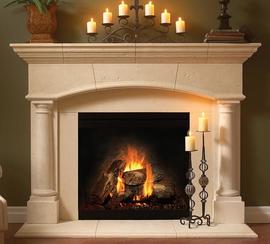 1 Mantel: A decorative construction that frames the opening of a fireplace. The term "mantel" can also refer to a shelf above a fireplace
1 Mantel: A decorative construction that frames the opening of a fireplace. The term "mantel" can also refer to a shelf above a fireplace
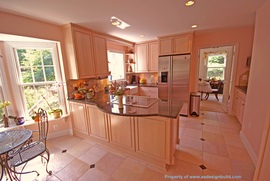 3 Peninsula: A metaphorical term for an extended kitchen counter space connected to the wall on only one side
3 Peninsula: A metaphorical term for an extended kitchen counter space connected to the wall on only one side
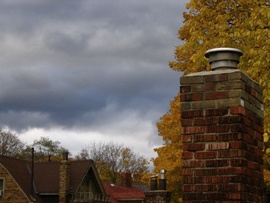 4 Flue: A duct or pipe through which exhaust gases from a fireplace, stove or boiler are released to the outdoors
4 Flue: A duct or pipe through which exhaust gases from a fireplace, stove or boiler are released to the outdoors
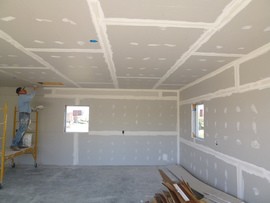 5 Drywall: Type of plasterboard, commonly used to build walls and ceilings, composed of gypsum that is layered between sheets of heavy paper
5 Drywall: Type of plasterboard, commonly used to build walls and ceilings, composed of gypsum that is layered between sheets of heavy paper
 6 Stucco: A type of durable plaster finish made of aggregates, a binder, and water (traditionally Portland cement, sand, and water) used on masonry, walls, ceilings, and decorative moldings
6 Stucco: A type of durable plaster finish made of aggregates, a binder, and water (traditionally Portland cement, sand, and water) used on masonry, walls, ceilings, and decorative moldings
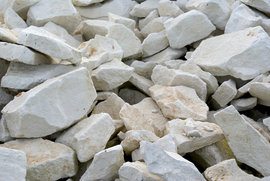 9 Limestone: A type of sedimentary rock, made up of mostly calcite and aragonite
9 Limestone: A type of sedimentary rock, made up of mostly calcite and aragonite
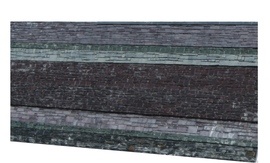 10 Slate: A fine-grained rock, typically bluish-gray in color, that can easily be split into thin layers and is commonly used as a roofing material
10 Slate: A fine-grained rock, typically bluish-gray in color, that can easily be split into thin layers and is commonly used as a roofing material
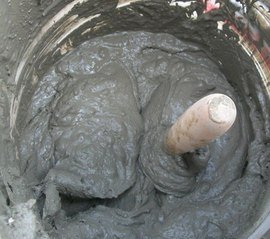 11 Mortar: A mixture of Portland cement or lime or a combination of both, sand, and water used to bind bricks, stones, and concrete masonry units together
11 Mortar: A mixture of Portland cement or lime or a combination of both, sand, and water used to bind bricks, stones, and concrete masonry units together
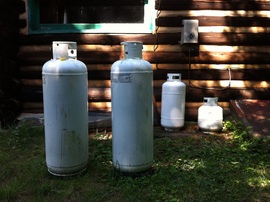 12 Propane: A hydrocarbon gas used as a common fuel source
12 Propane: A hydrocarbon gas used as a common fuel source
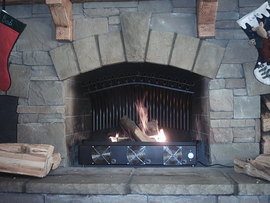 13 Blowers: An accessory that makes a fireplace more efficient by circulating the warm air in the fireplace to other areas of the home
13 Blowers: An accessory that makes a fireplace more efficient by circulating the warm air in the fireplace to other areas of the home
How much does it cost to install a gas fireplace in my city?
Cost to install a gas fireplace varies greatly by region (and even by zip code). To get free estimates from local contractors, please indicate yours.









